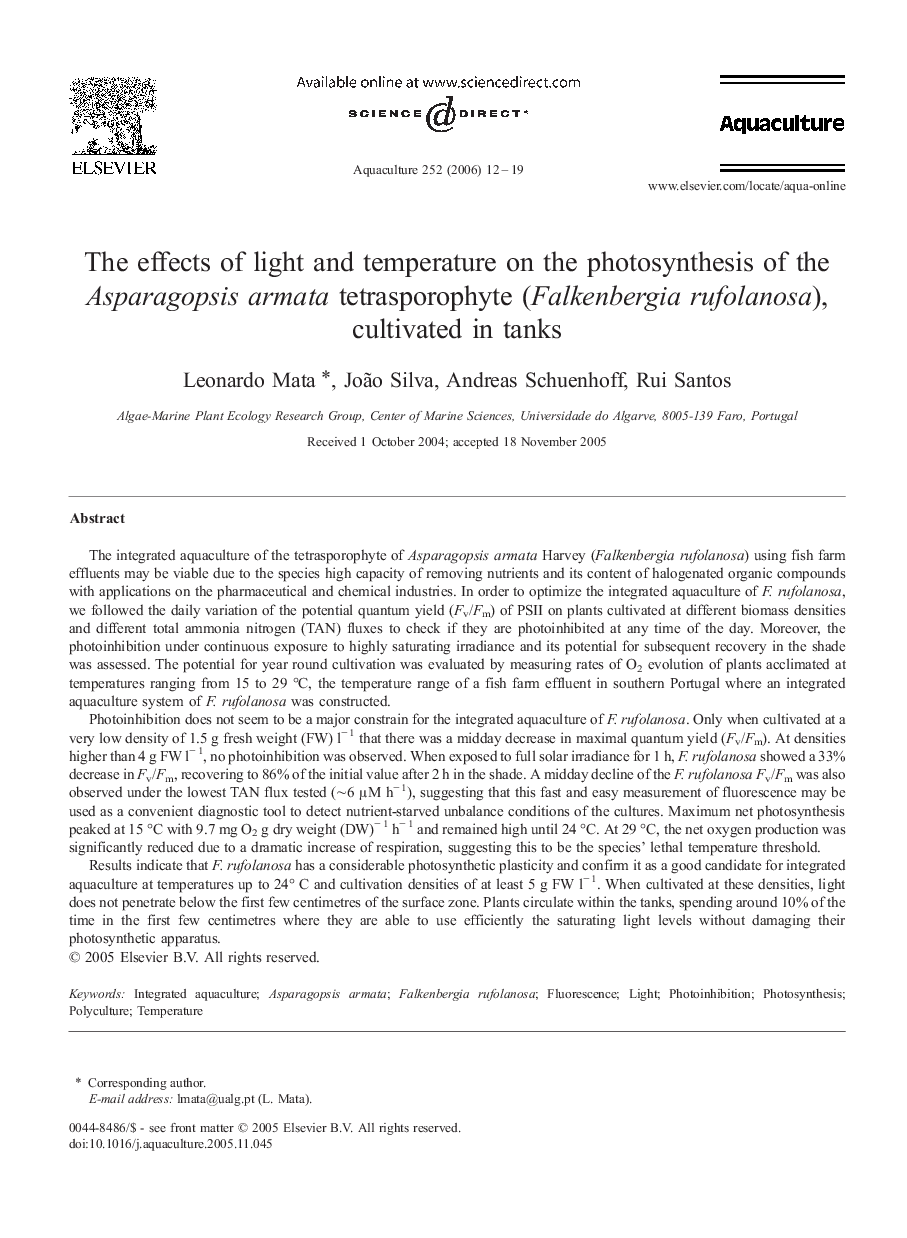| کد مقاله | کد نشریه | سال انتشار | مقاله انگلیسی | نسخه تمام متن |
|---|---|---|---|---|
| 2426288 | 1105358 | 2006 | 8 صفحه PDF | دانلود رایگان |

The integrated aquaculture of the tetrasporophyte of Asparagopsis armata Harvey (Falkenbergia rufolanosa) using fish farm effluents may be viable due to the species high capacity of removing nutrients and its content of halogenated organic compounds with applications on the pharmaceutical and chemical industries. In order to optimize the integrated aquaculture of F. rufolanosa, we followed the daily variation of the potential quantum yield (Fv/Fm) of PSII on plants cultivated at different biomass densities and different total ammonia nitrogen (TAN) fluxes to check if they are photoinhibited at any time of the day. Moreover, the photoinhibition under continuous exposure to highly saturating irradiance and its potential for subsequent recovery in the shade was assessed. The potential for year round cultivation was evaluated by measuring rates of O2 evolution of plants acclimated at temperatures ranging from 15 to 29 °C, the temperature range of a fish farm effluent in southern Portugal where an integrated aquaculture system of F. rufolanosa was constructed.Photoinhibition does not seem to be a major constrain for the integrated aquaculture of F. rufolanosa. Only when cultivated at a very low density of 1.5 g fresh weight (FW) l− 1 that there was a midday decrease in maximal quantum yield (Fv/Fm). At densities higher than 4 g FW l− 1, no photoinhibition was observed. When exposed to full solar irradiance for 1 h, F. rufolanosa showed a 33% decrease in Fv/Fm, recovering to 86% of the initial value after 2 h in the shade. A midday decline of the F. rufolanosa Fv/Fm was also observed under the lowest TAN flux tested (∼6 μM h− 1), suggesting that this fast and easy measurement of fluorescence may be used as a convenient diagnostic tool to detect nutrient-starved unbalance conditions of the cultures. Maximum net photosynthesis peaked at 15 °C with 9.7 mg O2 g dry weight (DW)− 1 h− 1 and remained high until 24 °C. At 29 °C, the net oxygen production was significantly reduced due to a dramatic increase of respiration, suggesting this to be the species' lethal temperature threshold.Results indicate that F. rufolanosa has a considerable photosynthetic plasticity and confirm it as a good candidate for integrated aquaculture at temperatures up to 24° C and cultivation densities of at least 5 g FW l− 1. When cultivated at these densities, light does not penetrate below the first few centimetres of the surface zone. Plants circulate within the tanks, spending around 10% of the time in the first few centimetres where they are able to use efficiently the saturating light levels without damaging their photosynthetic apparatus.
Journal: Aquaculture - Volume 252, Issue 1, 1 March 2006, Pages 12–19